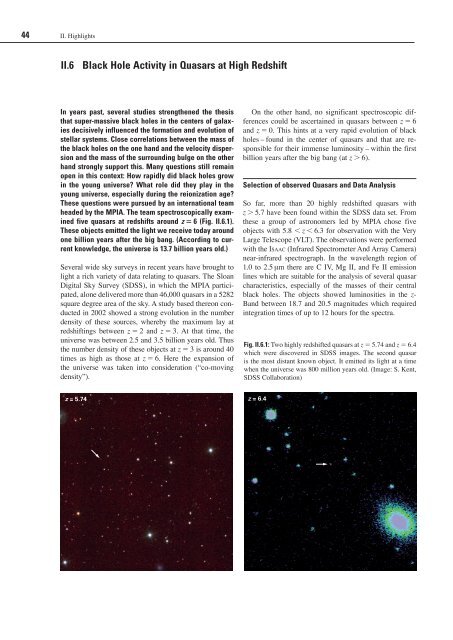Max Planck Institute for Astronomy - Annual Report 2007
Max Planck Institute for Astronomy - Annual Report 2007
Max Planck Institute for Astronomy - Annual Report 2007
Create successful ePaper yourself
Turn your PDF publications into a flip-book with our unique Google optimized e-Paper software.
44 II. Highlights<br />
II.6 Black Hole Activity in Quasars at High Redshift<br />
In years past, several studies strengthened the thesis<br />
that super-massive black holes in the centers of galaxies<br />
decisively influenced the <strong>for</strong>mation and evolution of<br />
stellar systems. Close correlations between the mass of<br />
the black holes on the one hand and the velocity dispersion<br />
and the mass of the surrounding bulge on the other<br />
hand strongly support this. Many questions still remain<br />
open in this context: How rapidly did black holes grow<br />
in the young universe? What role did they play in the<br />
young universe, especially during the reionization age?<br />
These questions were pursued by an international team<br />
headed by the MPIA. The team spectroscopically examined<br />
five quasars at redshifts around z 6 (Fig. II.6.1).<br />
These objects emitted the light we receive today around<br />
one billion years after the big bang. (According to current<br />
knowledge, the universe is 13.7 billion years old.)<br />
Several wide sky surveys in recent years have brought to<br />
light a rich variety of data relating to quasars. The Sloan<br />
Digital Sky Survey (SDSS), in which the MPIA participated,<br />
alone delivered more than 46,000 quasars in a 5282<br />
square degree area of the sky. A study based thereon conducted<br />
in 2002 showed a strong evolution in the number<br />
density of these sources, whereby the maximum lay at<br />
redshiftings between z 2 and z 3. At that time, the<br />
universe was between 2.5 and 3.5 billion years old. Thus<br />
the number density of these objects at z 3 is around 40<br />
times as high as those at z 6. Here the expansion of<br />
the universe was taken into consideration (“co-moving<br />
density”).<br />
z = 5.74<br />
On the other hand, no significant spectroscopic differences<br />
could be ascertained in quasars between z 6<br />
and z 0. This hints at a very rapid evolution of black<br />
holes – found in the center of quasars and that are responsible<br />
<strong>for</strong> their immense luminosity – within the first<br />
billion years after the big bang (at z 6).<br />
Selection of observed Quasars and Data Analysis<br />
So far, more than 20 highly redshifted quasars with<br />
z 5.7 have been found within the SDSS data set. From<br />
these a group of astronomers led by MPIA chose five<br />
objects with 5.8 z 6.3 <strong>for</strong> observation with the Very<br />
Large Telescope (VLT). The observations were per<strong>for</strong>med<br />
with the is a a c (Infrared Spectrometer And Array Camera)<br />
near-infrared spectrograph. In the wavelength region of<br />
1.0 to 2.5 µm there are C IV, Mg II, and Fe II emission<br />
lines which are suitable <strong>for</strong> the analysis of several quasar<br />
characteristics, especially of the masses of their central<br />
black holes. The objects showed luminosities in the z-<br />
Band between 18.7 and 20.5 magnitudes which required<br />
integration times of up to 12 hours <strong>for</strong> the spectra.<br />
Fig. II.6.1: Two highly redshifted quasars at z 5.74 and z 6.4<br />
which were discovered in SDSS images. The second quasar<br />
is the most distant known object. It emitted its light at a time<br />
when the universe was 800 million years old. (Image: S. Kent,<br />
SDSS Collaboration)<br />
z = 6.4

















